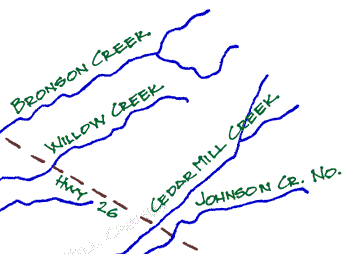 The Nature of Cedar Mill The Nature of Cedar Mill
What Good is a Watershed?
By Gretchen Vadnais, Landscape Architect
A watershed is all the land that drains into a river or creek. It is
separated from other watersheds by ridgetop boundaries. When
it rains or snows in a watershed, all that water eventually enters
the water body, either through surface water or groundwater.
In our area the watersheds of Cedar Mill, Willow, Beaverton, Bronson
and Johnson Creeks contribute to the Rock Creek Watershed. The Rock
Creek Watershed in turn is part of the larger Tualatin River Watershed
which drains into the Willamette. The creeks of our watersheds
have their headwaters in the steep slopes of the Tualatin Hills.
The creeks coming down from the steep hills are rocky and swift. As
they reach the valley floor they enter a landscape that was filled
with beaver and beaver dams before the valley was developed.
The water that comes to a creek from an undisturbed watershed is caught
by vegetation, soil and wetlands, and is released slowly over the
course of years. This is part of the function of a watershed; to store water,
to filter it, and release it. The woods immediately surrounding a
creek (the riparian woods), the mature forest beyond this, the soft duff
of the forest floor, and the open grasslands of the early valleys, all helped
to store and filter water.
When this absorbent surface is covered over with roofs and asphalt,
water runs into streams much more directly, carrying whatever washes
off these surfaces. Water running over hot asphalt drains into pipes
which empty directly into the closest stream, in most cases. This
warm, chemical-laden water encourages algae and damages the native inhabitants.
There used to be fish in most of our local streams, as many local fishermen
can attest.
The sudden increase in the amount of water running into the creek
and the speed of the water has several damaging effects: scouring
the debris and soil off of the bottom of the creek (home to many
critters), causing downcutting, and eroding banks.
The various pollutants that each stream carries eventually must be treated
before they reach the Tualatin River. Treatment is expensive, and
the dirtier the water the more it costs. And the higher your sewer bill
is.
This effect has been recognized – this is why you see so many collecting
basins or swales. Every new development has one, of one sort or another,
meant to settle and/or filter some of the pollutants out and to release the
water more slowly.
Regulatory agencies have only recently begun to acknowledge the importance
of healthy watersheds by mandating setbacks for wetlands and other “mitigating” restrictions
or requirements. We can all do our part to promote watershed health by limiting
our use of garden chemicals, increasing the permeable surface on your property,
and using commercial car wash facilities which are required to filter their
soapy water before it reaches a stream.
|
